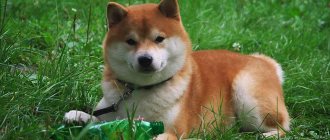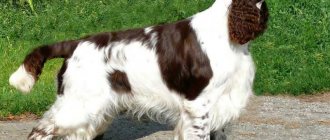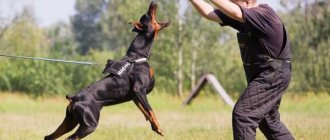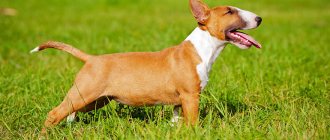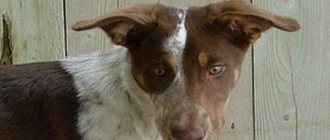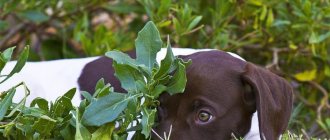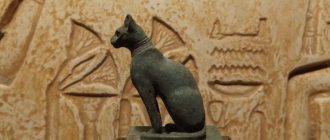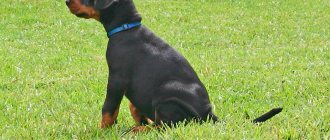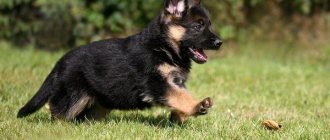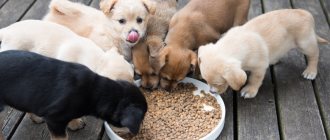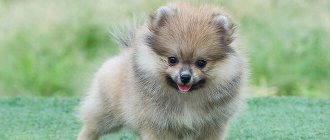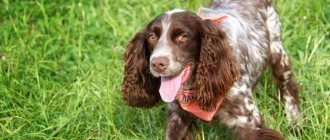History of the breed
Shiba Inu puppies appeared in Japan more than 9 thousand years ago. At least, this is what the found animal remains indicate. Other scientists believe that dogs first appeared only in the 3rd century BC. In any case, this breed is quite ancient and famous.
However, the breed itself was officially registered only at the beginning of the 20th century. Throughout the country there were many different variations of representatives of these dogs and they were all called Shiba Inu, or in other words “little dog”. This is because they stop growing at the age of 8-10 months.
The dogs were very helpful. They were used for hunting and kept at home to catch rodents. Perhaps this is why dogs began to have a specific independent (like cats) character.
Interesting! For a long time, the breed did not leave Japan due to the country's isolation. The Shiba Inu came to Russia only towards the end of the 20th century.
At what age do you start training?
Puppy training must begin from the very first days
the presence of a dog in your home. Because already from infancy, the puppy must learn the rules of behavior in your house, what is allowed and what is forbidden, how to behave with all family members, even the smallest and oldest, what he can play with and what he can’t, where to go. toilet and much more.
And we are talking, first of all, about the proper upbringing of a Shiba Inu puppy, and you can start training and learning commands when the puppy is completely comfortable in your home. As a rule, one week is enough. By this time, the puppy is already filled with curiosity and is diligently exploring the world around him. If, after this time, the puppy remains fearful and does not make contact well, then it is better to seek help from a dog handler-animal psychologist, because This behavior is not typical for puppies of this breed.
When can you start training with a dog handler?
The beginning of the puppy's training coincides with the time of the first exit to the street. When the first two vaccinations have already been done, the quarantine (lasts 7-14 days, depending on the vaccination) after them is over. It is not at all necessary to train your puppy only outside; the first sessions are best done at home, where there are fewer distractions.
Often new puppy owners worry that training from the first days will be excessively stressful for the dog. This is only possible if outdated, rigid methods are used, and with the right approach, training from the first days will, on the contrary, be very useful, since it allows you to immediately establish contact
with the puppy and build a trusting relationship.
You can start raising a puppy from the first days of its appearance in your home, and training and classes with a dog handler can begin simultaneously with the start of walks, when quarantine ends after the second vaccination.
Why you don't need to wait up to 6 months
You often hear that Shiba Inu, like other dogs, cannot be trained before 6 months, because training is stressful. This opinion remains from the times of outdated methods based on cruel coercion and intimidation of the dog. Unfortunately, there are still plenty of dog handlers using similar techniques today. But fortunately, science does not stand still and modern techniques make it possible to train a puppy from the first days in a new home. Therefore, you should not wait until your Shiba Inu puppy develops unwanted behavior; you can start training much earlier.
Description of the breed
The Shiba Inu puppy, or “little dog,” is a relatively small dog with a proportional build. Muscular legs help to develop fairly good speed and pursue prey.
The dogs have a wide skull and well-defined muscles. Triangular-shaped ears always stick up. The tail is wrapped in a ring and lies partially on the back.
The breed has a specific tail
Dog appearance (standards)
Dimensions
Males of this breed are 40 cm tall, and females are 37 cm tall. Females weigh from 7 to 9 kg, males weigh a little more: from 10 to 13 kg. Small deviations in one direction or another are allowed.
A larger female dog should still have a feminine appearance, and an inconspicuous small dog should have well-developed muscles.
Wool
A representative of the breed has a coat consisting of two layers. The top layer is distinguished by long and coarse hair, while the bottom layer consists of soft and short undercoat. There is short hair on the animal's face. The dog's fur fits tightly to the body, with the only exception being the fluffy tail.
Colors
The most popular color of a dog of this breed is bright red. It is he who is given the greatest preference. In addition to this color, there are several others recognized as a standard. This is a black color with tan, as well as a zonal color, in which the color spots are unevenly distributed.
Zonar colors come in sesame, red sesame and black sesame. Just sesame is when black and white hairs are placed in relatively equal proportions on the animal’s body. With red sesame, red hairs predominate in color; with black sesame, black hairs predominate.
Animals with a completely white color look very chic. But such Shiba Inus will not be able to qualify for participation in exhibitions, since their color is not recognized as a standard.
Teeth and jaws
The dog's teeth are white and strong, its jaws are quite powerful.
Eyes
The Shiba Inu has brown, deep-set eyes that are shaped like a triangle.
Body and limbs
The animal is built very proportionally, its body is muscular and strong. The paws are quite strong, with the hind legs being more powerful than the front ones.
Tail
The Shiba Inu dog has a high-set tail. It seems to be wrapped in a ring, wide at the base. In general, the tail is thick and strong, covered with hair that does not fit tightly, rather sticks out.
Rock defects
Disqualifying defects for the Shiba Inu breed are as follows: inappropriate coloring, sagging ears, thin short tail or tail not wrapped in a ring, missing teeth, malocclusion; the dog's aggressiveness or cowardice.
Advantages and disadvantages
The exterior has a large number of both positive and negative qualities. Among the advantages stand out:
- Cleanliness. Dogs take care of themselves and try to keep their fur in order. However, they do not like to swim.
- The animal is smart enough to learn quickly.
- Attractive physical characteristics.
- Shiba Inu dogs are completely indifferent to loud noise. They are not shy, which makes it possible to keep them in a city apartment.
As for the minuses, they are as follows:
- Dogs are very stubborn and do not like to obey. Therefore, their upbringing needs to be done from an early age.
- Dogs are cunning and never admit their guilt. Such a dog will smile rather than make sad eyes.
- Dogs are actors. It is because of their cunning that pets can manipulate their owners by making faces, whining pitifully, screaming, and so on.
Important! Representatives of this breed are not suitable for everyone. A person himself must have a strong character in order to train such a pet.
These dogs are not without acting talent
How to raise a Shiba Inu puppy
If you train your pet correctly, then over time you will get an obedient dog that will follow all commands and delight you every day. Experts believe that several factors may influence the Shiba Inu's susceptibility to following various commands:
- pet's temperament - the speed of the pet's reaction to stimuli, both positive and negative;
- character - how exactly the dog resists various unpleasant influences;
- obedience - the dog’s ability to accept human leadership;
- vigilance - the speed with which the dog notices potential danger, both in relation to itself and in relation to the owner;
- aggressiveness - the pet’s ability to react hostilely to potential danger;
- curiosity - interest that is developed when a dog feels, hears and sees something;
- sociability - the ability to interact with people;
- possessiveness is the interest shown by animals in certain objects, for example toys.
How quickly your dog will learn commands depends on which traits predominate in the character of a Shiba Inu puppy. By paying attention to the character traits of your animal, you can find an approach to it and adjust its behavior in certain situations.
- Eagerness will get you nowhere . You should not try to teach your Shiba Inu puppy all the commands at the same time; you need to learn the commands one by one. You need to have patience and act methodically. You should not scold your pet at the moment when he makes mistakes, and when he succeeds in something, then the pet should be encouraged.
- Don't hit . It is prohibited to use physical punishment against a pet until it is three months old. You should limit yourself to variable intonation, but avoid shouting. Once a Shiba Inu puppy is three months old, it is allowed to use a light spank as punishment while saying the phrase “Ew.” It is necessary to punish immediately when the animal commits an offense, and not after it, since the animal simply will not understand what exactly it was punished for.
- Subsequence . The main goal is to ensure that the pet follows the command the first time. Commands should be pronounced clearly and in an even voice so that the dog understands and obeys you. All family members should be involved in raising the dog, but they must act together. It is forbidden to allow situations in which you scold the puppy, and another family member praises him or simply does not pay attention.
- Pamper . Remember to reward your Shiba Inu puppy with a variety of treats and praise when he has done what is asked of him.
Breed standard
Adult animals are small in size. According to established standards, boys reach 36-40 centimeters at the withers, weight varies from 9 to 14 kilograms. For girls, height should be 32-36 cm, weight 7-12 kg. Variations of 1-1.5 cm in height and 1-2 kg in weight are allowed. Everything else is already a waste.
Head
The proportions of the head, nose, ears and eyes should be average. The skull is wide. The distance between the edges of the skull should be less than between the ears. The cheekbones are pronounced. All transitions are smooth and soft.
Jaws and teeth
Scissor bite. The fangs are powerful. Protruding or crooked teeth are not allowed.
Nose
The nose is straight. Regardless of color, the lobe always remains black. The sizes are average.
Eyes
The eyes are small and deep-set. They have a slight bevel when viewed to the side. In most cases the color is dark brown, although other shades are rare.
Ears
The ears are medium size, triangular in shape. They are always in a standing position. Located in front. When viewed from the side, the ears are visually an extension of the body.
Neck
The neck looks quite powerful. Visually adds greater muscle and strength to the animal. Smoothly transitions into the body.
Frame
Muscular, massive and strong. Physique abilities are expressed in high physical data. The dog can withstand increased loads and run for a long time.
Shiba Inu loves active walks
Limbs
Proportional, elongated and strong. Closely pressed to the body. The hind legs are distinguished by long thighs and developed shins.
Tail
Set high. Always twisted into a ring. Thick due to thick fur.
Wool
The fur is long and hard. The guard hair is needle-shaped. The undercoat is dense and short. The length of the fur differs in different parts of the body.
Color
According to standards, colors are divided into 3 color options:
- ginger;
- black and tan;
- sesame.
The fur is not monochromatic. In the area of the abdomen, muzzle, paws and tail there are light, including white, areas. This is normal for this breed.
Varieties of color of the breed
Disqualifying faults
Vices or defects include everything that is not included in the standard. For example:
- different fur color;
- hanging ears;
- tail that is too short or droopy;
- disproportionate physique;
- mestizo - or a cross with other breeds;
- crooked or missing teeth and so on.
Features of care
Cleanliness is the main trait of the Shiba Inu breed. The puppy becomes one from the age of 3 months. Therefore, there are no problems or special features in care. There is much less hassle with a Siba than with other dogs.
Familiarize yourself with the nuances of breeding dogs of the Alaskan Malamute, Yorkshire Terrier, Akita Inu, Labrador Retriever, Jack Russell Terrier, Beagle, Chihuahua, Bull Terrier, Pit Bull, Rottweiler, Pomeranian Spitz, Cane Corso, German Shepherd.
Wool
Grooming is the most difficult part of caring for a pet in general. The Japanese husky has a very thick undercoat. During the molting period, which occurs twice a year, it requires combing twice a day. At other times - traditionally 2-3 times a week. You need to scratch in different directions with different brushes: both metal and rubber.
Shiba does not need to be cut, otherwise it will not meet the standard. Only the fur between the pads on the paws needs to be trimmed.
Ears, eyes, teeth, claws
To care for your eyes and ears, you need to buy a special product from a veterinary clinic. Once a week you should wipe your eyes and ears with a cotton swab soaked in the product.
If you and your dog often walk for a long time, the dog will wear down its claws on the asphalt or hard ground. Therefore, you need to trim your claws with a special pruning shears once every two weeks.
If grinding does not occur because you walk with your dog in parks and squares, he runs mainly on the grass, then you need to trim his nails more often. You definitely need to brush your teeth. To do this, you need to purchase a special brush and meat-flavored paste. Clean once every 3-4 days.
Bathing
Bathing a dog is often not allowed. Yes, and there is no need for this. As already mentioned, the Shiba is a very clean dog. During a walk, she will never get into a puddle or mud, she will definitely go around it. Wool is designed in such a way that moisture and wet dirt do not penetrate it, but come off easily when shaken off.
The pet will wash its paws itself. Dust and dirt irritate the animal. After the walk, the dog lies down and washes its paw pads and claws for a long time. So it is enough to bathe your Shibu Ina twice a year. The exception is severe contamination (which is unlikely with this level of cleanliness).
Walks
Dogs need an active lifestyle. Therefore, walks should be frequent and long. Active games are required. The dog needs a lot of physical activity.
A dog will be grateful to its owner if he takes it for a morning run, plays with it in the yard at lunchtime, and exercises it in the evening. Walks must be interesting. The effect of novelty is important: a new route, a new game or toy, a new exercise. You need to walk your dog on different types of soil: asphalt, rocky soil, lawn, path in the forest. In general, an adult dog should have at least 1.5-2 hours of active walking per day.
To protect your pet's paws from damage and dirt, use dog shoes.
Nutrition
Japanese huskies are unpretentious eaters. They don't need variety. Content with small portions. You can feed him prepared food or natural food.
You should take into account the fact that this is a breed of dogs with allergies, so the best option for nutrition is a well-selected ready-made super-premium food.
Important! Never overfeed your dog.
It is better, of course, to feed with high-quality, balanced dog food containing about 30% protein and 15-18% fat. The food can be soaked or given dry. At 2 months, the puppy eats 1/3 cup of dog food three times a day. As you grow older, the portion is gradually increased.
From 8 months we switch to two feedings a day. An adult Shiba needs 1-1.5 glasses of food per day. If the dog has not finished the portion, it must be removed after 15 minutes. Can be given at the next feeding.
Important! When changing food, the transition should be gradual over 10 days.
If you choose natural nutrition, you must remember a certain set of rules:
- any food at room temperature;
- “straight girl” – from 1.5 years of age;
- meat - only beef;
- cut the meat into small pieces, not mince;
- frozen meat, pour boiling water over it;
- bird bones are prohibited;
- porridge: only steamed Hercules or boiled rice;
- It is not allowed to give river fish;
- alternate sea fish with meat;
- vegetables, fruits, greens, blanched, raw, with 3 drops of vegetable oil;
- boiled quail eggs only 1-2 times a week with shell;
- raw eggs are not allowed;
- hard cheeses, smoked meats, sweets, flour, nuts are strictly prohibited;
- be careful with milk and fermented milk products - there may be an allergy (do tests);
- You cannot feed the dog from your hands or from your table;
- periodic vitamin complexes are required;
- constant access to clean water.
Dogs can be prone to obesity. Therefore, you need to feed in such a way that the spine and ribs are palpable and do not stick out. Sometimes you can reward your dog with treats, especially during training.
Italian greyhound character
The character of this breed is very capricious and even harmful. Not every person is suitable for such a friend. They are often compared to cats precisely because of their disposition. The dog constantly needs to be shown who is boss (without cruelty, of course), otherwise the animal will challenge the position of leader.
The pet is not active, so you can safely keep it at home or in an apartment. However, the animal still needs a kind of release. Therefore, it is recommended to have such dogs for people who are interested in sports or hunting.
The Shiba Inu gets along quite well with children and other pets, with a small amount of leniency. He will treat the child like a furry nanny, but it is better to get a puppy when there are older children in the house so that they can play with the dog.
When to start training your puppy
The baby's training begins immediately after purchase.
The common belief that they begin to train a pet at six months of age is incorrect. Rules of behavior in the house are instilled from the first day. Inexperienced owners consider this to be very stressful for the animal, but with a delicate approach it will help establish contact with the pet and begin to build trust between the owner and the puppy. Shiba Inu training begins at 2 months. At this time he is in quarantine due to vaccination and does not go for walks. They are taught to go to the toilet wearing a diaper. Training a puppy to be hygienic is a long process, and initial results do not guarantee success. Training continues according to plan so as not to repeat it. They are taught to use a leash, collar and muzzle at home. When the dog goes outside, he will experience stress from wearing accessories.
At two months of age, the puppy is given boundaries and rules. Playing is allowed with toys, not with the owner's things. Biting hands during the game is prohibited. Attempts to chew clothes, shoes, furniture, and barking without a command are suppressed.
Take the Attention Test! Find 10 differences! (click right here!)
Find the answer Are you bothered by some problem or question? Enter “Breed” or “Name of the problem” into the form, press Enter and you will find out everything about the issue that interests you.
At this stage of training, harsh punishments are avoided and praise is preferred so that the dog does not grow up embittered or intimidated. The dog is allowed to explore the world around it as long as it does not go beyond the established limits.
Education and training
Shiba Inu puppies are raised from an early age, literally from the first months. It all starts with something simple: remembering the dog’s name and where it belongs. It is important to constantly educate your pet so that it behaves normally in society.
Important! You can’t spoil your dog with treats often. Otherwise, the pet begins to cheat and extort food in all available ways.
Training is very important for the breed
Raising a pet
To avoid many social problems, you should start working with your pet from childhood. Shiba does not require any special training, you just need to adhere to some basic rules:
- Accustom your dog to interact with people and animals from childhood. This will dull her possible aggression towards strangers in adulthood,
- This breed is very energetic and is well suited for active people. During long and busy walks, the dog will play enough and behave calmly at home,
- If you still do not have the opportunity to walk your dog for a long time, then his claws may not be worn down enough. In this case, they must be trimmed,
- In an effort to suppress your dog's increased activity, avoid frequent twitching and screaming. It will make her nervous and cowardly,
- Pet and hold your pet often at an early age. This way he will get used to your touch and subsequently will not break out every time you decide to pet him,
- Shiba Inu has very developed leadership qualities, but this does not mean that they need to be extinguished and completely crush him under you. It is much better to keep him on an equal footing and avoid roughness and painful punishment.
Maintenance and care
The dog can live both at home and in an enclosure. For the latter, they have quite thick and warm wool. They do not require any additional clothing in winter. The only thing you should take care of if the dog lives outdoors is a booth and a sun canopy.
At home, the dog must have his own place, which he must know. You can get a special cage and leave the animal there while people are not at home. The main thing is that it is roomy and comfortable enough. It is also recommended to leave the animal's favorite toys in the cage so that it does not get bored.
General training course
The general training course is based on systematic training. The skills developed during the general course form the basis for the formation of conditioned reflexes in the animal.
The first skill is to teach the puppy to go to the toilet only outside. During the learning process, it is necessary to practice instructions with gestures and voice.
General skills and abilities include:
- Response to nickname;
- Habit of a collar, leash, harness;
- Approach to the trainer;
- Walking nearby;
- Habit of lying, sitting, standing, crawling positions;
- Ability to follow voice commands, stop certain actions, overcome obstacles;
- Refusal of other people's food;
- Tolerance to noise stimuli.
Features of feeding and diet
You should feed with quality products. The diet must be balanced. When giving preference to dry food, you should choose only premium or super premium class. However, they must be specialized.
Please note that the dog is allergic to some types of meat. The thing is that food and life on the islands at one time left their mark in this regard.
The home diet should not include:
- pork and chicken;
- vegetables containing starch;
- onion;
- smoked meats;
- pickles;
- sweets;
- flour.
Food must be chosen correctly
How to choose a puppy
You can get a real purebred puppy either from a professional breeder or from a nursery. If someone offers an inexpensive option, then most likely the person is faced with a mixed breed or a defective puppy.
How much will the dog cost? In a kennel or shelter, a Shiba Inu will cost significantly more - from 1000 to 1500 dollars. The cost of a baby without documents will be 300-500 dollars, but it will no longer be suitable for exhibitions.
It is necessary to choose the baby correctly. It is recommended to familiarize yourself with his pedigree or parents (if possible). The dog should also be examined. He must have clean eyes, nose and ears. There should be no signs of illness or malnutrition.
Which version of the nickname is most suitable for a pet is up to the owner to decide. Here are several options for what you can call a Shiba Inu: Hao, Hachi, Budo, Ken, Aiko, Jun.
How to properly care for a Shiba Inu?
The Japanese Shiba Inu dog is unpretentious, but you should carefully monitor your pet's health. As the fur gets dirty, it needs to be bathed regularly. However, it is important not to overdo it. After all, the Shiba Inu’s fur remains clean for a long time and does not smell like a dog. If there is no obvious contamination on it, there is no need for water procedures.
Brushing the coat once a week is enough. During the molting period, the procedure is carried out daily. The shed undercoat that covers the skin at this time is a favorable climate for the spread of dangerous bacteria.
The Shiba Inu does not need clothing to protect itself from the cold. This breed has a dense coat and a thick undercoat. But in inclement weather it is better to go for a walk in a waterproof raincoat. It will prevent the wool from getting wet. Thanks to this, additional lubrication will not be produced, and the dog will not need a bath soon. After walking in a raincoat, you only need to wash your paws.
Every day the owner should:
- examine the eyes and ears to make sure there are no redness or damage;
- check paw pads for cuts and cracks;
- feel the body, as during a walk the dog may be bitten by a tick or injured.
Ears should be cleaned as needed. If you find plaque on your teeth, you can clean them yourself or contact a veterinarian. You need to visit your doctor regularly. Shiba Inus are prone to a number of diseases, such as hip dysplasia, hypothyroidism, and they often have vision problems. During the examination, the veterinarian has a chance to detect the disease at an early stage and take the necessary measures.
An important issue in caring for a Shiba Inu is nutrition. It can be natural or industrial. In the first case, the basis of the diet is meat porridge and raw foods, and in the second - dry and wet food. Once you take a puppy into your home, you should not change its diet for the first six months of life in the new place. He must adapt, and then the owner can choose whether the diet will be natural or whether the main product will be ready-made food.
The Shiba Inu, the photo of which is presented in the article, is a beautiful breed with a complex character. It requires careful attention and constant care from the owner. However, a dog of this breed will respond to the affection and care of its owner with boundless devotion and love, and will become a faithful friend and companion in all matters.
Interesting Facts
Some interesting facts about the breed:
- Despite their harmful nature and habits, Shiba Inus are the most loyal and devoted dogs. This, at one time, was proven by the well-known Hachiko.
- At home, the dog mainly ate fish, seafood and algae.
- Dogs are very curious and always try to discover new horizons for themselves.
As you can understand, Shiba Inus are unusual dogs that are not suitable for everyone. However, if the dog does recognize its person, it will remain faithful and devoted until the end of its life.
Differences from Akita Inu
After watching videos of Shiba Inu on the Internet, many people mistake it for an Akita. Yes, outwardly they have some common characteristics, but they are completely different breeds, although they belong to the same species. The main difference is, of course, height: the Akita is much larger. In addition to external differences, there is a huge difference in the character of these dogs. Akita is a very calm dog, many people mistakenly believe that it gets along with children, but this is not the case. This dog does not like importunity and children's fuss. Even among its relatives, Akita rarely finds a common language with anyone. This dog is a loner, like a real Japanese samurai, he is devoted to his owner.
The Shiba Inu is a very playful and cheerful dog. At any age, your Japanese friend will remain as active as in childhood. Although the Shiba does not bark very often, it works very responsibly as a watchman, and will definitely give a signal when a stranger appears. They can also make interesting sounds using their larynx. In general, Akita and Shiba Inu are complete opposites, and they can only be confused in appearance.
